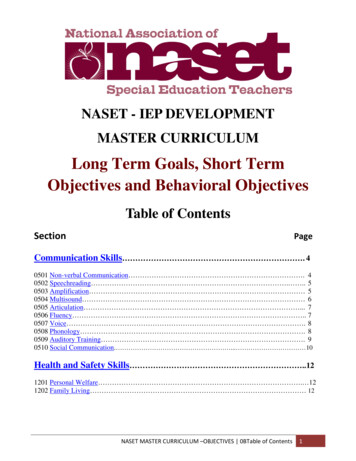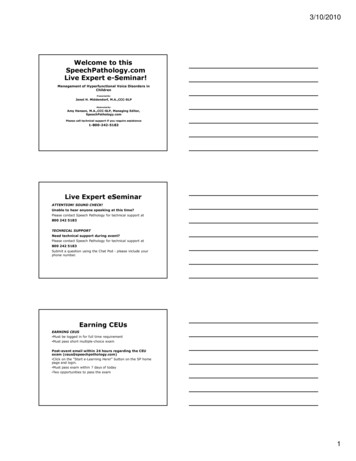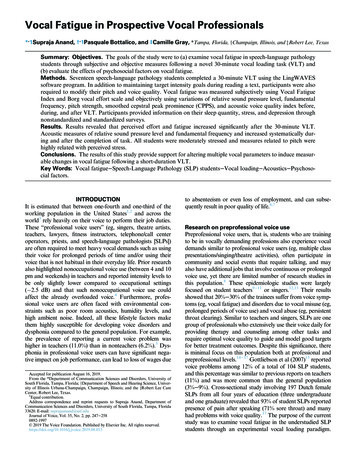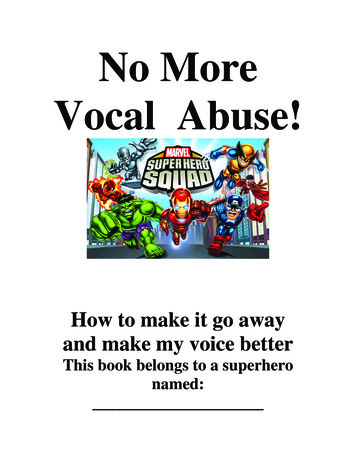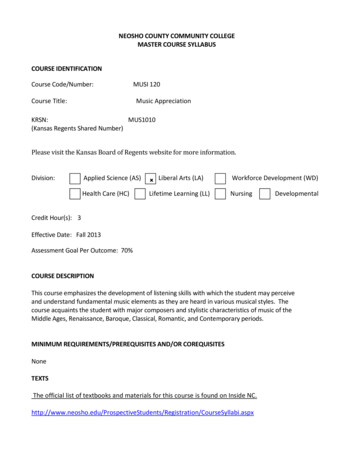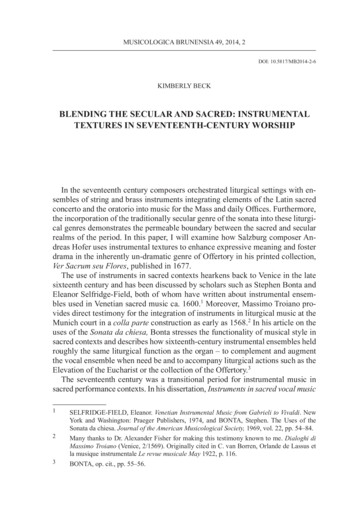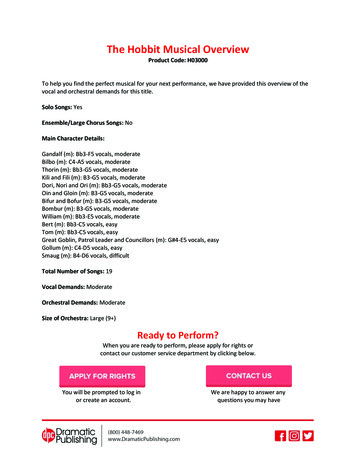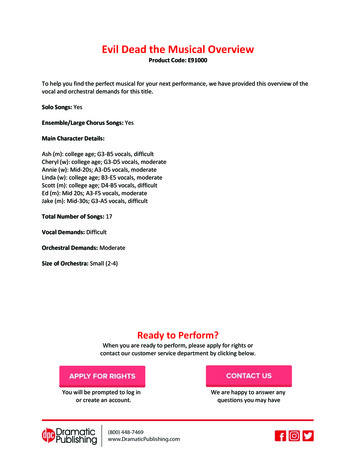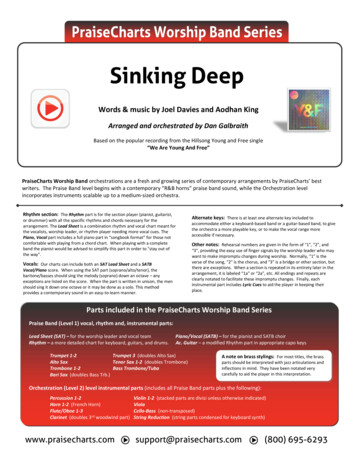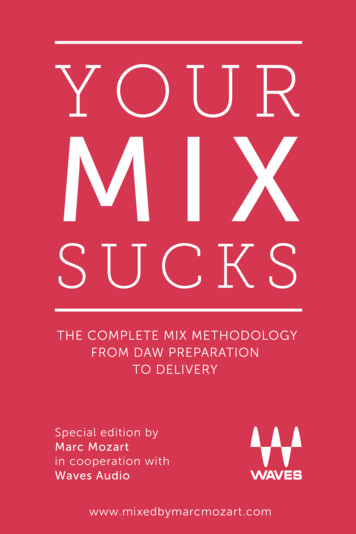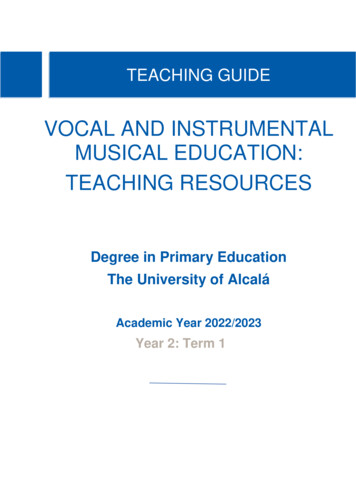
Transcription
TEACHING GUIDEVOCAL AND INSTRUMENTALMUSICAL EDUCATION:TEACHING RESOURCESDegree in Primary EducationThe University of AlcaláAcademic Year 2022/2023Year 2: Term 1
COURSE GUIDEName of subject:Vocal and Instrumental Musical Education:teaching resources.Course code:430003Degree program:Degree in Primary EducationDepartment and field:Department: Learning SciencesField: Didactics of expression through musicType of class:MandatoryECTS credits:6Year and term:Second year: first termTeaching staff:Dr. Rafael Villanueva LiñánTutoring schedule: Monday 10:30 – 11:30; Thursday 11:00-14:00Language of instruction:English1. COURSE DESCRIPTIONBasic musical contents such as writing, reading, critical audition, scales, intervals, tonalities,acoustics and other theoretical subjects there will be treated with a practical approach. Studentswill learn to compose and perform using both acoustical and IT resources. Starting our academictrip with the sound, we will continue with rhythm, melody, harmony, and basic musical forms.2
2. AIMS AND OBJECTIVESBy the end of the course students will:General skills:1. Understand the principles that contribute to cultural, personal and social development throughthe arts.2. Become familiar with aspects of the school curriculum regarding audio-visual and musicaleducation.3. Acquire the conceptual tools to encourage lifelong participation in musical activities inside andoutside of school.4. Develop and evaluate the contents of the curriculum through the use of appropriate didacticresources and promote development of students’ skills.5. Learn how to create quality teaching materials to further develop the Primary Educationcurriculum.Specialized skills:6. Understand and appreciate the value which musical education has for personal and emotionaldevelopment, as well as its role in the development of critical reflection and social interactionskills.7. Learn and understand the basic techniques of musical composition, improvisation andinterpretation, which could be of use in the primary teaching profession.8. Correctly adapt activities and musical education course contents to the level they are beingtaught at and be able to propose curriculum changes consistent with these. Have the ability todevelop a curriculum through the use of appropriate teaching resources.9. Make use of appropriate technical and intellectual resources in the classroom to enable diversestylistic and aesthetic alternatives regarding the many music-based forms of expression.3
3. COURSE CONTENTSUnitsIT resources for reading/ writing basic musical notation.Pulse, rhythm and meter.The melody: Study of intervals and scalesHarmony: chords, chord symbol, progressions andsuccessions.Music composition.Musical forms: theory and practice (auditoryperception).Total number of classes,credits or hours. 7 class contact hours. 14 hours independentstudy. 5 class contact hours. 10 hours independentstudy 7.5 class contacthours 15 hours independentstudy 6.5 class contacthours. 13 hour independentstudy 14 class contacthours 28 hours independentstudy 10 class contacthours. 13 hours independentstudy 6.5 class contacthours.Elements of sound. Basic acoustics. 13 hours independentstudy4
4.1. Distribution of credits (specify hours)Number of class-contact hours:50 hoursNumber of independent study hours:100 hoursTotal number of hours150 hours4.2. Methodological strategy, teaching materials and resourcesClass contact hoursCourse materials and resourcesIndependent study Theory classes andtheoretical/practical classes in largegroups and in smaller groups. Instructive classes to present(presentation) and emerge thestudents in complex topics, allowingthem to form conclusions. Classes focused towards developing,applying and expanding knowledge oftopics through the use of differentstrategies: solving case studies,problem solving, role-play, debates Group tutorials Printed materials (books, sheet music,journal articles) Audio-visual materials (Internet, onlineplatforms, recordings) Technological resources (computers,audio-visual players, software,projectors, screens) Reading5
Complete activities and exercises,provide examples, research.5. ASSESSMENT: Procedures, assessment and grading criteriaAssessment criteria1. For course content covered during class contact hours: Learn the key concepts and principal theories of each topic. Integrate and apply course content to diverse situations. Solve problems perceptively. Present ideas coherently. Draw ideas together in a comprehensive manner. Correct spelling and adequate register for text type.2. For completed coursework and practical work: Originality. Accuracy. Clarity and strong theoretical grounding. Integration of theory and practice. Correct spelling and adequate register for text type.Grading criteria6
1. Distinction: Complete mastery of basic learning outcomes. Formation of ideas based of consideration and application of acquired knowledge. Completion of all assigned tasks.2. Merit: Mastery of basic learning outcomes. Good level of reflection in the learning process. Adequate complete of most assigned tasks.3. Pass: Mastery of basic learning outcomes. Good level of reflection in the learning process. Completion of a sufficient number of assigned tasks.4. Fail: Low level of understanding and poor application of learning outcomes. Low level of reflection in the learning process. Failure to participate in tasks assigned by the teacher.The final grade weighting is divided into: 40%: Acquisition of knowledge, demonstrated in a final exam 20%: Attendance and participation in practical and theory classes. 40%: Correct and satisfactory completion of assigned tasks such as exercises,andwritten tests and essays.Assessment proceduresThe subject is assessed using a combination of various assessment procedures in order toallow all students to reach their full potential. The performance of the student throughout theterm, that is to say, continuous assessment, is the primary assessment criteria. Overallevaluation is therefore based on:7
1. Attendance and participation in theoretical and practical classes.2. Completion of exercises, written exams and tests (including the final exam)The use of bibliographic and online resources is fundamental. Activities aimed at evaluatingthis will be completed by the student.Students have the option to take an end of term assessment as opposed to following thecontinuous assessment system. If the student wishes to do this they must apply in writing tothe Dean of the Faculty of Education in the first two weeks of the course. The end of termassessment procedure will be comprised of written exercises. Re-sit examinations will becomprised of an exam. The exam contains written exercises based on theoretical issues, aswell as practical exercises.If the health authorities consider it necessary to suspend the classroom teachingactivity or the circumstances of the subject require it, teaching, or part of it, wouldcontinue with the online methodology until the suspension was lifted, at which point itwould become to the face-to-face modality .6. BIBLIOGRAPHYARVELO, A. (Director).(2005). Tocar y Luchar [Video digital ampliado a 35mm].Venezuela: Centro Nacional Autónomo de Cinematografía / Cinema Sur.BALL, P. (2010). El instinto musical. Escuchar, pensar y vivir la música. Madrid: Turner.8
BLASCO, J. (2015). Música en el aula. Práctica para la composición musical. SGAE 2ªedición.CAVALIERI, M.C. (1998). Composing, performing and audience-listening as symmetricalindicators of musical understanding. University of London, Institute of Education(inédito).COLLADO, G. (2011). Yamaha ClassBand en España. Docenotas.com, 2 de -classband-en-espanaDIERSSEN, M. (2001). Neurobiología de la experiencia musical. Eufonía Didáctica de laMúsica, nº 21, enero 2001.FINKEL, D. (2008). Dar clase con la boca cerrada. Valencia: Publicacions de laUniversitat de Valéncia. (Versión original 2000).GARDNER, H. (2011). Frames of Mind: The Theory of Multiple Intelligences. (versiónoriginal 1983) Newcastle UponTyne (UK): Basic Books.9
KÜHN, C. (1974) Tratado de la forma musical. Barcelona: Idea Books S.A.MILLS, J. (2005). Music in the school.Oxford: Oxford University Press.PAYNTER, J., Aston, P. (1970). Sound and silence. CambridgeUniversity Press.PAYNTER, J. (1999). Sonido y Estructura. Madrid: Akal.PERRENOUD, P. (2004). Desarrollar la práctica reflexiva en el oficio de enseñar.Profesionalización y razón pedagógica. Barcelona: Graó.RODRÍGUEZ-QUILES, J.A. (2012). Del burro cantor la sombra. Educación musical enEspaña por movimiento cancrizante. Eufonía Didáctica de la Música, nº 54, enero2012, pp. 7-23.SCHOENBERG, A. (1943) Modelos para estudiantes de composición, Ed. RicordiAmericana. Buenos AiresSCHÖNBERG, A. (1974). Tratado de armonía, Madrid: Real Musical Editores.VILLANUEVA, R. (2014). La enseñanza musical instrumental en la enseñanzaobligatoria: análisis de la situación actual y la clase de cuerda como alternativa alcurrículo.Biblioteca de medicina y ciencias de la salud. campus universitario. 28871Alcala de Henares. (inédita).10
Tratado de armonía, Madrid: Real Musical Editores. VILLANUEVA, R. (2014). La enseñanza musical instrumental en la enseñanza obligatoria: análisis de la situación actual y la clase de cuerda como alternativa al currículo.Biblioteca de medicina y ciencias de la salud. campus universitario. 28871 Alcala de Henares. (inédita).
